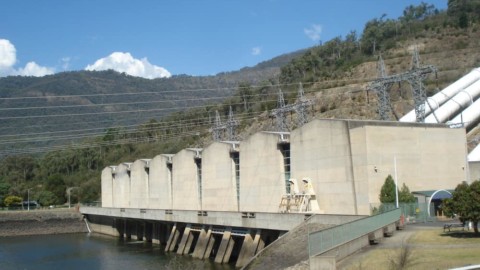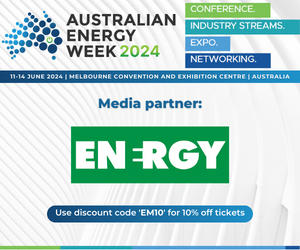Terms like altruism and space exploration are not usually synonymous with the energy industry. However, Reposit co-founder Dean Spaccavento is looking to a future where renewable energy is regarded as a sound investment option, climate change is remediated, energy is made available for free to all members of the community and we reach to the stars for new energy sources.
Reposit co-founder Dean Spaccavento has built a career on questioning everything, challenging the status quo and finding better and more efficient ways to do things.
His company Reposit has developed a smart home energy management system, which enables users to maximise their solar and battery set-up by tracking when and how households use electricity, and then sells excess energy for the highest possible price.
Since its inception in 2013, Reposit has achieved market success, generated savings and even revenue for its users, and has plans to expand overseas. But Mr Spaccavento’s motivation to develop products and solutions for the energy industry is not motivated by profit; it comes from his desire to negate the effects of climate change for the sake of his children – a responsibility he says we all share – and his social conscience to make energy freely available to everyone.
Motivating investors
From his early days in the energy industry – and thanks to a background in the world of banking – Mr Spaccavento realised that the key to securing finance for innovation within the energy industry was always going to be centred around proving and providing a solid return on investment.
“I don’t think it will be government policy getting investors on board; I don’t think it will be bleeding hearts; I don’t think it will be people trying to be green. No-one is taking a loss to fix climate change; it has to be done with a profit motive,” Mr Spaccavento said.
“Fortunately, it just so happens that now, electricity from renewables is zero marginal cost, and zero marginal cost is a very difficult thing to compete against.
“Solar is the cheapest source of generation. Depending on where you are, and what your marginal loss factor is, solar and storage is more cost-effective than coal today, and it’s just going to get more so.”
According to Mr Spaccavento, while it’s disappointing that the National Electricity Objectives which guide the industry do not have a climate component, the fact that investors are starting to recognise that investing in renewable energy is sound is an encouraging step forward for the industry – and, perhaps more importantly, the climate objectives of Australia.
Electric vehicles charging the way
Mr Spaccavento predicts that solid state batteries, used in electric vehicles, will be the next big thing in Australia’s energy industry.
“Solid state batteries will have increased energy density, better operating characteristics, and they will probably be able to be manufactured more cheaply and deliver higher power,” he said.
Advancements in this technology are being led by German, Japanese and Chinese companies, in response to market-leaders such as Tesla testing the waters with electric vehicles. The positive response to this technology has paved the way for other companies to develop a greater range of products, with a broader selection of price tags.
However, according to Mr Spaccavento, the big question that remains is how will users charge their electric vehicles in a way that is cost and energy efficient.
“The question outstanding here is what happens – do you end up with a home solar battery, as well as electric vehicles? Or do you end up with most households having two electric vehicles, one of them is in the garage more often than the other one, and effectively is there to catch the solar during the day at home, to be able to feed back into the home at night?
“We have customers charging their cars from their home solar batteries right now, and as a result they have mobility costs that are close to zero. Their home solar battery charges during the day, powers their home, and then charges their EV at night.”
And while Mr Spaccavento also notes that charging infrastructure, as well as the price of electric vehicles, are slowing our adoption of this technology, the tide is starting to turn pretty quickly, and it won’t be too far into the next decade that we start to see some major shifts in the Australian energy market thanks to electric vehicles and home solar batteries.
Energetic altruism
Mr Spaccavento said that while he was excited about the new opportunities technology brought to the energy industry, he grappled with the notion that early adopters of technology, who tended to be affluent, were the ones with access to new technologies, while other members of the community struggled from day-to-day in the face of rising electricity rates.
“All technology widens the wealth gap, that’s just the trend; we’ve seen it over the past 30 years and we will continue to do so,” he said.
However, Mr Spaccavento is optimistic that we’re heading towards a future where Australians can have energy for free.
“I think Australia, the population, the citizenry of Australia, can have energy for free, and it can be something that the Australian economy, or the electricity system provides,” he said.
“This could be achieved if Australia realised its potential as a global source of hydrogen, which can be produced from the abundant solar resource that we have.
Mr Spaccavento said that while free energy for everybody might be a while off, there was potential to help those struggling in the shorter-term.
“One of the things that would be useful is the donation of excess energy through peer-to-peer trading,” Mr Spaccavento said.
“I think anyone who’s got excess energy should be interested in helping people who can’t pay for the energy component so they get the energy for free. It’s not peer-to-peer trading; it’s peer-to-peer gifting.”
Virtual power plants
A combined community approach to energy is already being trialled in Sydney, where Reposit has partnered with Ausgrid to turn homes into ‘virtual power plants’.
Nearly 300 houses across 170 suburbs are taking part in the trial, which combines their solar and battery sources into one single unit.
“Virtual power plants are the next step in Australia’s energy revolution,” he said.
The NSW Government has also invested $20 million in 900 smart solar batteries to create a 13MW virtual power plant. This will turn hospitals and schools into mini power plants using solar panels and batteries, and is expected to save up to $40,000 per year. This initiative is designed to address the cost of running these facilities, which account for nearly half of the State Government’s energy bill. If successful, the government will expand the technology to other departments.
Shooting for the stars
When he’s asked about the future of energy, Mr Spaccavento says the sky is literally no limit.
“Asteroid mining is already something that people are paying attention to,” he said.
“As soon as there’s a commodity that’s got a very, very high volume and a good price attached to it, there will be a lot of investment spent.”
While he concedes that asteroid mining is probably about 30 years away, Mr Spaccavento says there are a number of projects and technologies that will play a key role in the short-term, such as hydro projects, hydrogen, 5G, high-temperature superconductors, power-handling semiconductors and insulated-gate bipolar transistors.
And, with a focus on sustainability and social responsibility, and the use of smart technology, he’s optimistic that the future of energy can be positive for everyone, now and in the future.

















